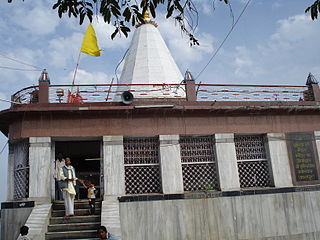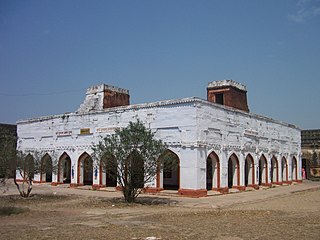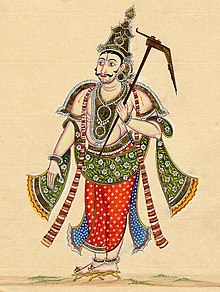
Banda is a city and a municipal board in Banda district in the state of Uttar Pradesh, India. Banda is divided among north, east, west, and south Banda. Banda lies south of the Yamuna river in the Bundelkhand region. It is the administrative headquarters of Banda District. The town is well connected to major cities with railways and state highways. The town is near the right bank of the river Ken, 189 km south-west of Allahabad.
Mahoba is a city in Mahoba District of the Indian state of Uttar Pradesh in the Bundelkhand region, well known for the ninth century granite Sun temple built in Pratihara style. It is also well known for the 24 rock-cut Jain tirthankara image on Gokhar hill. Mahoba is known for its closeness to Khajuraho, Lavkushnagar and other historic places like Kulpahar, Charkhari, Kalinjar, Orchha, and Jhansi. The town is connected with railways and state highways.

Prithviraja III, popularly known as Prithviraj Chauhan or Rai Pithora, was a king from the Chauhan (Chahamana) dynasty who ruled the territory of Sapadalaksha, with his capital at Ajmer in present-day Rajasthan. Ascending the throne as a minor in 1177 CE, Prithviraj inherited a kingdom which stretched from Thanesar in the north to Jahazpur (Mewar) in the south, which he aimed to expand by military actions against neighbouring kingdoms, most notably defeating the Chandelas.

Maihar is a city in the Maihar district of the Indian state of Madhya Pradesh. Maihar is known for the temple of the revered mother goddess Sharda situated
Atrauli is a town and a municipal board in Aligarh district in the state of Uttar Pradesh, India. Situated on the bank of the river Ganges, Atrauli is around 27 km (17 mi) from Aligarh and 52 km (32 mi) from Khair.
Alha was a legendary general of the Chandel king Paramardideva, who fought Prithviraj Chauhan in 1182 CE. He is one of the main characters of the Alha-Khand ballad.

The term Alha Khand is used to refer to poetic works in Hindi which consists of a number of ballads describing the brave acts of two 12th century Banaphar heroes, Alha and Udal, generals working for king Paramardi-Deva (Parmal) of Mahoba against Prithviraj Chauhan of Ajmer. The works has been entirely handed down by oral tradition and presently exists in many recensions, which differ from one another both in language and subject matter. The Bundeli, Bagheli, Awadhi, Bhojpuri, Maithili, and Kannauji recensions are the most well known among these.
Dhadhor is a clan of inferior Ahirs and they are reckoned in the Tushreeh-ul-akwam amongst the Doab Ahirs.
Ahir is a caste found in the Indian subcontinent, mainly modern-day Northern India, Pakistan, Afghanistan and Nepal. The Ahir clans are almost spread over all the Northern India. Historians such as P. M. Chandorkar, using both literary and epigraphic sources has argued that the modern Ahirs should be identified with the Yadavas of the classical Sanskrit texts.

General elections were held in British India between 28 October and late November 1926 to elect members of the Imperial Legislative Council and the Provincial Legislative Councils.

Sujrai State was a princely state in British India. In legend it formed part of the mythological land of Braj ruled by Krishna.
Akhil Bharatiya Kshatriya Mahasabha also known as All India Kshatriya Mahasabha was founded in the year 1897 It was formed to promote, protect and fight for rights and interests of Kshatriya community of the Indian society.
Krishnaut or Kishnaut Ahir is a clan of the Yadav (Ahir) caste found in Bihar, Jharkhand and Nepal. The term Krishnaut which to them denotes their descent from Lord Krishna.

Khet Singh Khangar was one of the rulers of Garh Kundar.
Frederic Salmon Growse was a British civil servant of the Indian Civil Service (ICS), Hindi scholar, archaeologist and collector, who served in Mainpuri, Mathura, Bulandshahr and Fatehpur during British rule in India.

Rau Karna is a village in Sikandarpur Sarausi block of Unnao district, Uttar Pradesh, India. It is located 11 km north of the city of Unnao, on the road to Hardoi. On the east side of the village is the Tinai, a small stream that dries up in hot weather. The village holds a market twice per week. Rau Karna is part of the nyaya panchayat circle of Banda Khera.
Shakti Dan Kaviya was a poet, writer, critic, and scholar from Rajasthan, India. Kaviya had served as the department head of Hindi as well as Rajasthani section multiple times at Jai Narain Vyas University. He was considered an authority in Dingal (Rajasthani) literature as well as a great scholar of Hindi and Braj-Bhasha. Kaviya was also a Sahitya Akademi Award recipient for his work 'Dharti Ghani Rupali'

The Naigaon-Rebai or Naigawan-Rebai was one of the small estate of India during the period of the British Raj. It was a non-salute princely state in the Bundelkhand Agency. The state was founded in 1807 by Thakur Lakshman Singh. He received charter (sanad) to rule from the British Raj.
Isuri (1838—1909) is a Bundeli poet from Bundelkhand region. He is credited with having composed over a thousand Phaag, a form of folk songs.









